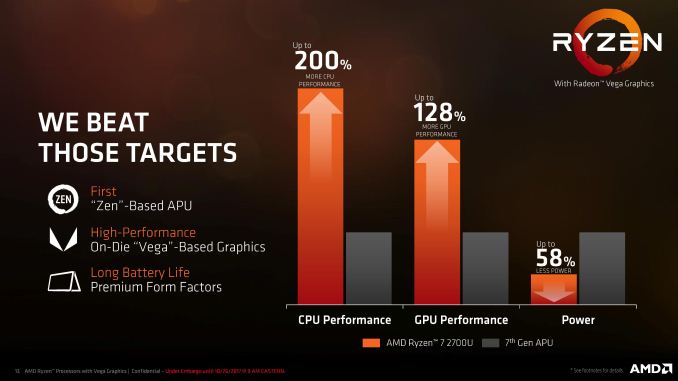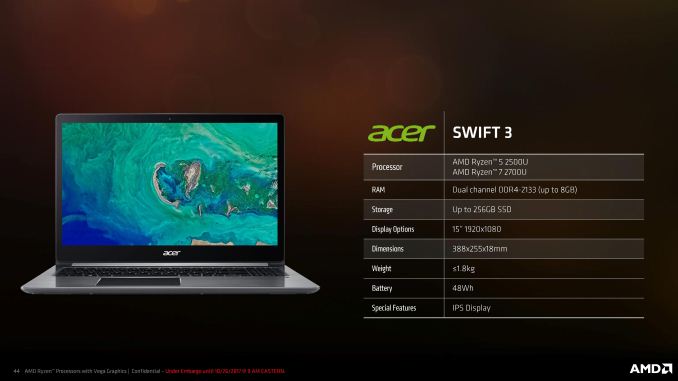Ryzen Mobile is Launched: AMD APUs for Laptops, with Vega and Updated Zen
by Ian Cutress on October 26, 2017 9:00 AM ESTAMD Ryzen Mobile: Zen 1.5
During our pre-briefings on Ryzen Mobile, it was asked why the two new APUs were using the 2000-series numbers, and not the 1000-series numbers like the desktop parts. It was assumed by the press that the first generation of Ryzen would all be under the 1000-series, including the mobile parts. The response given by Kevin Lensing, AMD’s Corporate VP of the Client Business Unit, was that so many of the design ideas that AMD wanted to put into the original desktop Ryzen (but couldn’t due to time) eventually ended up in Ryzen Mobile, such as the updated precision boost. While there are no architectural changes to Zen to warrant a next-generation microarchitecture name, this version of Ryzen’s periphery (i.e. the power) was more in-line with an original vision and had to be presented as such. This is why we have Ryzen 7 2700U, rather than a Ryzen 7 1700U. He would not comment if the true next generation Ryzen desktop naming would still be the 2000 series, or if we would go straight to 3000. Who knows, it might alternate.
The state of Zen aside, AMD’s return to high-performance computing with the Zen core was naturally going to trickle down into the notebook space. The question everyone asked is if such a high-power, high-performance core was going to make it in such a small power envelope: especially when you add some big graphics core next to it. In our desktop Ryzen reviews, we saw per-core power go as low as 8W per core, and AMD’s Vega was power hungry – promising to put four cores and some graphics into a single piece of silicon with a 15W TDP sounded harder than an uphill task, almost Sisyphean in nature. AMD has approached that by taking new methods to its power topology, how it manages that power, and found a combination of frequencies and performance that tally up to that 15W mark. They have also worked closely with the first three OEMs that are launching systems today to ensure a good user experience.
For performance, Ryzen Mobile has four cores with multithreading, with frequencies up to 3.8 GHz. This should give the mobile processor enough grunt under the hood in the 15W envelope to cater for a significant number of demanding workloads. GPU performance is also up, with AMD also hoping to push the hardware into a number of gaming-focused devices with FreeSync panels in the new few months. AMD is also touting significant power reductions during high-load tasks, leading to a 270% performance per watt improvement. More impressive is the steps taken towards how the processor manages power between cores and the GPU: a very complex implementation hopefully leading to a better power profile and 15-30% better battery life than previous generations for common use cases.
For the launch, AMD has partnered with HP, Acer and Lenovo for systems to go on shelves. As I am currently writing this, only HP provided any information about their upcoming systems and we’re likely to scramble when the other press releases come out. None of the three designs are ultimate eye-catching flagships, but rather approaching that middle-range $600-$1000 notebook territory with 13.3 inch 4K displays, up to 1TB SSDs, 48-55Wh batteries, and a device or two that can flip into a tablet. When we played briefly with the Acer unit in our pre-briefing, there was no lag – a user would be hard-pressed to immediately see a difference to a comparative Intel system.
Ultimately AMD has several very hard tasks ahead of it for Ryzen Mobile. Firstly it has to re-educate the sales teams at brick and mortar stores like Best Buy, who have only ever seen AMD has the low-cost budget option. If they still think the same way when Ryzen Mobile comes to town, they won’t be recommending them.
Second, they have to educate the public – after years of miserable user experiences leading to negative feedback loops, AMD has to convince these users that it is worth looking at AMD-powered devices again and there isn’t some sort of catch. Part of this solution will be in how well AMD integrates itself into the OEM sampling strategy for reviews, and if any reviewers are going to get devices this time around.
Third, AMD is several steps behind Intel in its marketing message: while Intel is trying to explain new ways to use the hardware (such as the failed ‘PC Does Whaaat?’ campaign almost a couple of years ago to the day), AMD is on the ‘I’m here too, and I’m just as good’ message. Back when we analyzed the Carrizo user experience, one thing we pointed out is that with most Intel flagships, most users do not even know what processor is inside – to these customers, saying ‘I’m just as good’ might give the impression ‘well what was wrong before?’. It might take AMD a round of flagships and XPS 13 or Zenbook Infinity-type designs to get the attention on their side of the discussion.
We have reached out to all three of the main OEMs who have Ryzen Mobile systems being announced today, but only one responded in time. This doesn’t bode well for any sampling, but we’re sitting here with a megaphone until we get one. Stay Tuned.
As part of this launch, AMD also discussed its progress towards its 25x20 goal, and AMD actually provided some data on how they are calculating this. We analyzed what AMD still has to do in a separate article, and you can read about it here:
http://www.anandtech.com/show/11965/amds-progress-on-its-25x20-goal-the-task-ahead














140 Comments
View All Comments
SaturnusDK - Thursday, October 26, 2017 - link
A few comments"If we look at processors from Intel that are 4C/8T, like the 35W Core i7-7700T, this scores 777 in our testing, which kind of drives away from AMD’s point here."
Not really. You're still comparing a 35W part to a 15W part, so 90% of the performance for 43% the power consumption is still a massive gain. What it really says is the 4T processor, be it with 2C or 4C is truly dead for anything but the lowest tiers. Something Intel have also realized in their current line up.
" In our desktop Ryzen reviews, we saw per-core power go as low as 8W per core, and AMD’s Vega was power hungry"
Vega is really only power hungry when pushed beyond ~1200MHz. Underclock it to that and Vega is extremely power efficient.
smilingcrow - Thursday, October 26, 2017 - link
"Vega is really only power hungry when pushed beyond ~1200MHz. Underclock it to that and Vega is extremely power efficient."This is very relevant for laptops but most desktop users don't seem to care as they want performance rather than efficiency and that is how AMD configure them.
SaturnusDK - Thursday, October 26, 2017 - link
Correct. It's also relevant to miners for example that generally run their GPU at around 1GHz as it's the optimum for power cost vs. performance. However, the article is about mobile CPUs, and in that respect it might have been a good idea to mention that running lower clocks rates drastically lowers the Vega power consumption which is exactly what has been done in these APUs.extide - Friday, October 27, 2017 - link
Yeah, but that 35W part could sustain that performance for a much longer time, if not indefinitely. The 15W AMD part (and likewise 15W Intel parts) will throttle down a fair bit after sustained use. According to AMD the R7 2700U drops to ~550 on cinebench after a 5-min loop. (Last slide on page 3)SaturnusDK - Friday, October 27, 2017 - link
It's possible it could sustain it for longer. We don't know that though. And even 550 points is still a massive performance per watt advantage to the AMD part. 770 points at 35W is 22 points per watt while 550 points (sustained) at 15W is 36.67 points per watt. A whooping 66.7% performance per watt advantage.neblogai - Friday, October 27, 2017 - link
550 points are at 25W, 450 at 15W as said in note regarding AMD slide 19.ruthan - Thursday, October 26, 2017 - link
If could be AMDs TDP value trusted, it could be finally good CPU/GPU for SmachZ or GPD gaming devices.. Present Atoms and AMD solution are very slow for decent mobile gaming..IGTrading - Thursday, October 26, 2017 - link
You cannot compare Intel's Atom with AMD's Carizo.It would be nonsense. Atom is an extremely low performance part that is barely able to equal the gaming performance of a Pentium 4.
Moreover, AMD's TDP values are the ONLY ONES TRUSTWORTHY while Intel was proven to respect the TDP when they feel like it and also they change the TDP definition almost every year.
AMD's Ryzen processors don't step 2% outside their rated TDP no matter the load scenario.
Intel's 8700K and 7980XE can reach a + 16% on their rated TDP.
So I'm inclined to trust AMD's specifications 100% more than Intel's.
t.s - Thursday, October 26, 2017 - link
A good read, Ian! Thanks!Bateluer - Thursday, October 26, 2017 - link
I was very interested in that Lenovo Ideapad 720S model, 13.3in with a 4K screen and the 2700U? Seems like it'd be a nice upgrade from my current Yoga 900 after underwhelming options in 910 and 920. Then I read that was going to stuck in single channel with only PC4-2133. That makes it significantly less attractive.